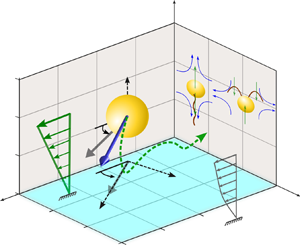Article contents
Slippery rheotaxis: new regimes for guiding wall-bound microswimmers
Published online by Cambridge University Press: 17 July 2023
Abstract

The near-surface locomotion of microswimmers under the action of background flows has been studied extensively, whereas the intervening effects of complex surface properties remain hitherto unknown. Intending to delineate the shear-driven dynamics near a planar slippery wall, we adopt the squirmer model of microswimmers and employ a three-dimensional analytical-numerical framework in bispherical coordinates. It is interpreted that both the self-propulsion and the external shear flow are redistributed due to hydrodynamic slippage, followed by modulations in the thrust torque on the microswimmer. Phase portraits of the quasi-steady dynamics indicate that the stable upstream swimming states, known as ‘rheotaxis’, are significantly modulated by the slip length compared with the no-slip case. For puller swimmers, an intricate interplay among the modulated interfacial friction near a slippery surface, velocity gradients of the shear flow and the strength of the squirmer parameter promotes a critical shear rate beyond which a wide range of new rheotactic states exist. Consequently, an escaping microswimmer may exhibit rheotaxis or an existing rheotactic state annihilates due to crashing. Although stable states are absent for pushers without steric interactions, transitions from escaping and undamped oscillations to ‘rheotaxis’ occur in the presence of wall repulsion, but only until the other characteristics are overwhelmed by escape due to enhanced shear. Disclosing the ability of hydrodynamic slippage in broadening the scope of migration against a background flow for a wide range of parameters, the present work paves the way for investigations on the entrapment of microswimmers near complex pathways or sorting using selective rheotaxis.
- Type
- JFM Papers
- Information
- Copyright
- © The Author(s), 2023. Published by Cambridge University Press
References
- 8
- Cited by



